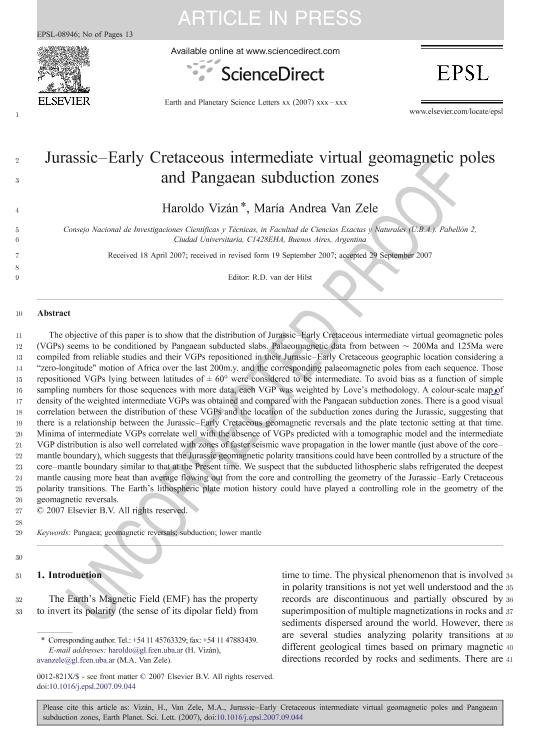Mostrar el registro sencillo del ítem
dc.contributor.author
Vizan, Haroldo

dc.contributor.author
Van Zele, Maria Andrea

dc.date.available
2019-04-23T19:57:29Z
dc.date.issued
2008-02
dc.identifier.citation
Vizan, Haroldo; Van Zele, Maria Andrea; Jurassic-Early Cretaceous intermediate virtual geomagnetic poles and Pangaean subduction zones; Elsevier Science; Earth and Planetary Science Letters; 266; 1-2; 2-2008; 1-13
dc.identifier.issn
0012-821X
dc.identifier.uri
http://hdl.handle.net/11336/74854
dc.description.abstract
The objective of this paper is to show that the distribution of Jurassic-Early Cretaceous intermediate virtual geomagnetic poles (VGPs) seems to be conditioned by Pangaean subducted slabs. Palaeomagnetic data from between ∼ 200Ma and 125Ma were compiled from reliable studies and their VGPs repositioned in their Jurassic-Early Cretaceous geographic location considering a "zero-longitude" motion of Africa over the last 200m.y. and the corresponding palaeomagnetic poles from each sequence. Those repositioned VGPs lying between latitudes of ± 60° were considered to be intermediate. To avoid bias as a function of simple sampling numbers for those sequences with more data, each VGP was weighted by Love's methodology. A colour-scale map (shadow-scale map in printed issue) of density of the weighted intermediate VGPs was obtained and compared with the Pangaean subduction zones. There is a good visual correlation between the distribution of these VGPs and the location of the subduction zones during the Jurassic, suggesting that there is a relationship between the Jurassic-Early Cretaceous geomagnetic reversals and the plate tectonic setting at that time. Minima of intermediate VGPs correlate well with the absence of VGPs predicted with a tomographic model and the intermediate VGP distribution is also well correlated with zones of faster seismic wave propagation in the lower mantle (just above of the core-mantle boundary), which suggests that the Jurassic geomagnetic polarity transitions could have been controlled by a structure of the core-mantle boundary similar to that at the Present time. We suspect that the subducted lithospheric slabs refrigerated the deepest mantle causing more heat than average flowing out from the core and controlling the geometry of the Jurassic-Early Cretaceous polarity transitions. The Earth's lithospheric plate motion history could have played a controlling role in the geometry of the geomagnetic reversals.
dc.format
application/pdf
dc.language.iso
eng
dc.publisher
Elsevier Science

dc.rights
info:eu-repo/semantics/openAccess
dc.rights.uri
https://creativecommons.org/licenses/by-nc-sa/2.5/ar/
dc.subject
Geomagnetic Reversals
dc.subject
Lower Mantle
dc.subject
Pangaea
dc.subject
Subduction
dc.subject.classification
Meteorología y Ciencias Atmosféricas

dc.subject.classification
Ciencias de la Tierra y relacionadas con el Medio Ambiente

dc.subject.classification
CIENCIAS NATURALES Y EXACTAS

dc.title
Jurassic-Early Cretaceous intermediate virtual geomagnetic poles and Pangaean subduction zones
dc.type
info:eu-repo/semantics/article
dc.type
info:ar-repo/semantics/artículo
dc.type
info:eu-repo/semantics/publishedVersion
dc.date.updated
2019-04-05T15:59:48Z
dc.identifier.eissn
1385-013X
dc.journal.volume
266
dc.journal.number
1-2
dc.journal.pagination
1-13
dc.journal.pais
Países Bajos

dc.journal.ciudad
Amsterdam
dc.description.fil
Fil: Vizan, Haroldo. Consejo Nacional de Investigaciones Científicas y Técnicas. Oficina de Coordinación Administrativa Ciudad Universitaria. Instituto de Geociencias Básicas, Aplicadas y Ambientales de Buenos Aires. Universidad de Buenos Aires. Facultad de Ciencias Exactas y Naturales. Instituto de Geociencias Básicas, Aplicadas y Ambientales de Buenos Aires; Argentina
dc.description.fil
Fil: Van Zele, Maria Andrea. Consejo Nacional de Investigaciones Científicas y Técnicas. Oficina de Coordinación Administrativa Ciudad Universitaria. Instituto de Geociencias Básicas, Aplicadas y Ambientales de Buenos Aires. Universidad de Buenos Aires. Facultad de Ciencias Exactas y Naturales. Instituto de Geociencias Básicas, Aplicadas y Ambientales de Buenos Aires; Argentina
dc.journal.title
Earth and Planetary Science Letters
dc.relation.alternativeid
info:eu-repo/semantics/altIdentifier/doi/http://dx.doi.org/10.1016/j.epsl.2007.09.044
dc.relation.alternativeid
info:eu-repo/semantics/altIdentifier/url/https://www.sciencedirect.com/science/article/pii/S0012821X07006309
Archivos asociados
